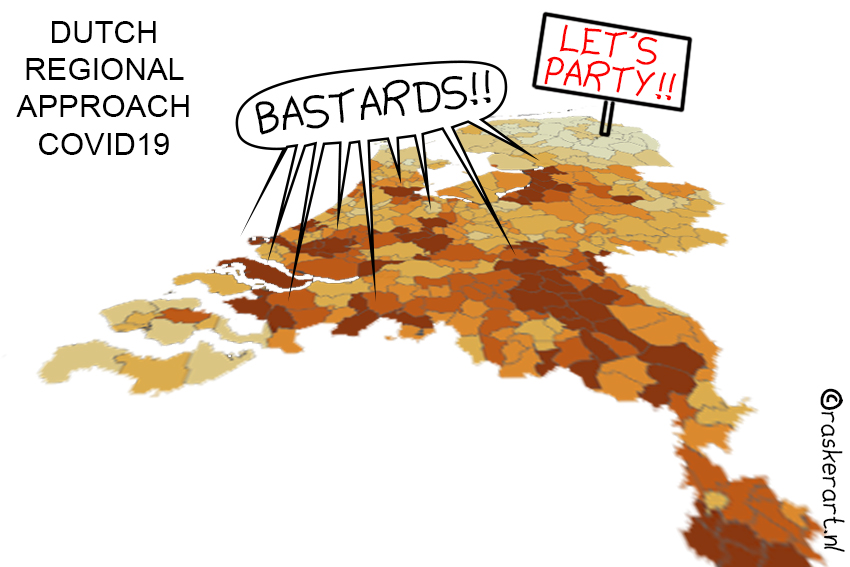
Meanwhile, it has been about six months since the first corona measures were introduced in the Netherlands. No new measures or tightening of the current regulations were announced at the press conference on 1 September. However, Minister Hugo de Jonge (Public Health, CDA party) did specify that there will be more room for local decision-making.
From now on, the government will categorize the risk of infection per region. Characterized as: Waakzaam, zorgelijk en ernstig (cautious, concerning, and critical). Also, the coronavirus dashboard has also included data per municipality as of this week. The dashboard is constantly updated with new data and studies. According to the minister, this supplemented local data enables regions to make a better estimate of which measures are needed and where.
This change of course stems from the recommendations of a group of more than one hundred experts. Recently, they have made contributions to various topics concerning the corona crisis. Themes such as testing and tracing, the effects of lockdown, and communication to the general public. Insights and advice have been collected and shared on all nine themes that the Cabinet can start working on.
Adherence to national policy
Ever since the pandemic began, it was already clear that the virus did not spread everywhere with the same severity. And that its spread varied from region to region. Several scientists immediately called for more testing and for more intensive source and contact tracing so as to map out the virus. The WHO also advised countries from as early as March to do as much testing as possible.
However, it took until 1 June before people in the Netherlands could be tested if they had mild symptoms. Before that date, only people with a fever, cough or shortness of breath could go to the Municipal Health Service (GGD) for a test. According to the National Institute for Public Health and the Environment (RIVM), this was done to detect the most vulnerable people more quickly and to treat them in time.
But given a clearer picture of where the virus is present, the generic lockdown could perhaps have become a regional lockdown. Like in North Brabant, for instance, just after the Carnival? At that time, there were still far too many uncertainties surrounding corona. Later, when hotbeds became more visible, the government shifted to tackling outbreaks on a more localized basis.
No more lockdowns ever again?
Experts, such as Prof. Dr. Ira Helsloot of the Governance of Safety and Security at the Radboud University, believe that the Netherlands should never again opt for a national lockdown. “This policy will directly cost tens of billions more. And will lead to at least half a million more people without an income,” he writes in an analysis of the measures. Very many of these people are poorly educated and will drop to social welfare levels. On average, this person lives two years shorter than someone on a normal income. Except that this is not yet reflected in the figures. Over the longer term, these measures will cause more deaths. By investing the money for the corona measures in healthcare, we could have ‘saved’ many more years of life.”
Other experts, such as Professor of Public Health Economics at Groningen University Jochen Mirau, have expressed fears that it is easier said than done to impose regional lockdowns. According to him, the Netherlands is a mish-mash of regions. 25 safety-related regions, 32 healthcare administration regions, 42 for youth care, and a further 11 Regionale Overleggen Acute Zorgketen (Regional Network for Acute Care Chain).
That is why Mierau recoomends that the Netherlands be divided up into six or seven health regions that are in charge of their own regional corona policy. “This avoids a confusing maze of policies. It also ensures that you can add a regional tint to national policy. Such an area would comprise of up to 3 million people. Each region then sets up its own Regional Corona Data Center where they collect the same basic sets of statistics. All these data are in turn linked to the Coronavirus Dashboard.”
Hard facts and figures and social impact
“Nationally, we need to agree on a set of defined measures that will be used regionally if certain values are exceeded. This will ensure that everyone knows what will be done and that the situation is clear. The infection rate, the number of hospital admissions, and the available – regional and national – care capacity must be the guiding principles in this,” Mierau writes.
However, in his view, attention must also be paid to the social impact of the measures in addition to hard facts and figures about the virus and the healthcare system. As an example, Mierau quotes the weekly Corona Barometer. You can find local figures about the North of the Netherlands here. Not only are there statistics on hospital admissions and infections, but refarding mental health as well.


